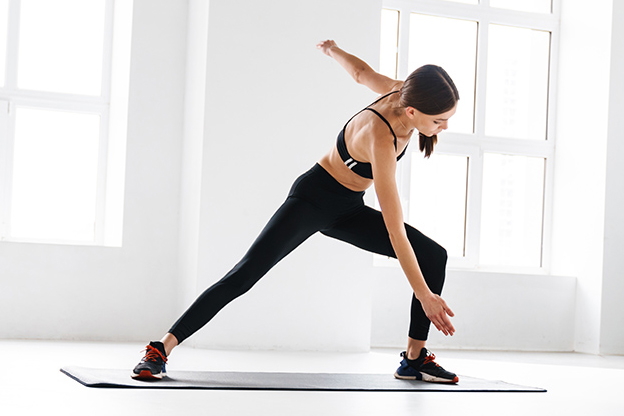Ectomorphs are slim-boned, long-limbed, lithe and have very little body fat and little muscle. This body type, also known as Vata in Ayurvedic medicine (used in India since ~3000 BC).
Ectomorphs are naturally thin, have little mass (fat and muscle) relative to their height and are relatively linear. People with an ectomorph body type can find it difficult to add muscle or even increase body fat.
Ectomorph Characteristics
In detail
Ectomorphs characteristics include:
- Naturally slim to skinny
- Small joints
- Small frame
- Lanky – long arms and legs
- Linear body shape
- Long, narrow hands and feet
- Lightly muscled – small, long and slender muscles
- Small chest and buttocks
- Low body fat (without exercising or following low calorie diets)
- Fast metabolism
- Easy to lose weight
- May find it difficult to gain weight
- Difficulty in gaining muscle mass
- Maintains relatively narrow weight/ BMI range
- Poor natural strength
The ectomorphic body type is often seen in endurance athletes, models, and basketball players.
Which Sports are Ectomorphs Good at?
Do the sports and activities you enjoy most. However, it’s worth noting that ectomorphs are naturally better at some sports than others. Ectomorphs have light bones, small joints, slender muscles. Therefore, ectomorphs often excel in sports requiring endurance and light weight, including long-distance running, triathlon, jogging and cross-country skiing.
Long limbs compensate for slower sprints and changes in direction. They also provide a decided advantage when it comes to sports requiring a long powerful stroke or jump, such as rowing, swimming, jumping, and basketball, as well as in sports calling for hitting and throwing. Long limbs allow ectomorphs to generate great speed due to a long range of motion in sports involving hitting or throwing a ball. Think of racquet sports, volleyball or baseball.1 People with an ectomorphic body type also tend to boast high flexibility.
Ectomorphs tend to have poor ligamentous support and a less robust build (compared to mesomorphs or endomorphs), which makes ectomorphs more susceptible to injury. Therefore, ectomorphs may not do as well in fast-paced aerobic-type exercise, such as sprinting and contact sports.
Long-distance swimming may not be a strength for ectomorphs due to lack of body fat, which is required for buoyancy, but they make for great speed swimmers. Ectomorphs also tend to have a high centre of gravity, making them less balanced and stable.
Nonetheless, while body types are helpful, they’re not destiny. Remember Usain Bolt. At the time, he was the unlikeliest of sprinters. Impossibly tall and lanky, towering over a field of mesomorphic sprinters. Still the world’s fastest man, his records haven’t been broken. So do what you love.

Body Composition: Muscle & Fat
While ectomorphs appear to be slim, this does not necessarily mean they have a healthy body fat percentage. Some ectomorphs may have a normal BMI, but unhealthy levels of body fat (and visceral belly fat) and less muscle mass. This is known as normal-weight obesity (or skinny fat).
Therefore, ectomorphs can benefit, as much as the other two body types, from measuring their body fat (composition). Ectomorphs tend to have less muscle mass and have a smaller frame, and so a healthy weight for ectomorphs may be a little lower than for endomorphs or mesomorphs (see the ideal weight calculator).
With age, even the super fast metabolism of ectomorphs slows down and as a result, they often gain weight. However, this is also an opportunity for ectomorphs to gain muscle.
Ectomorph Strategy
Ectomorphs with a higher body fat percentage often want to lose fat and gain muscle, while ectomorphs with low fat and muscle tend to want to gain weight – both fat and muscle.
Little muscle mass and long limbs means ectomorphs are not as strong as mesomorphs and endomorphs. Ectomorphs are also more likely to suffer with postural problems, such as forward head, rounded shoulders, and kyphosis (rounded back).2 Therefore, a large focus of an ectomorph workout plan should be on strength training. Adding muscle will increase strength, muscle tone, shape, and posture.
When it comes to diet, ectomorphs who want to gain weight, should include nutrient and calorie dense foods for snacks and meals, such as nuts, sunflower seeds, dried fruits, and vegetables. Also, some ectomorphs may want to try a weight gain diet.
If you are struggling to gain weight, it may be a good idea to visit your doctor to rule out any underlying medical conditions. People suffering with hyperthyroidism for example, experience weight loss and are unable to gain weight.



I don’t know who I am. I am tall 177 cm(or 5’10), naturally slim woman with very long arms and legs. My BMI is 17-19. On the other hand, I don’t have a linear body shape. My shoulders is quite broad(but chest is small) and my waist-to-hip ratio is about 0.7.
@April — This article is about the ectomorph body type, aka hardgainers, who struggle to gain weight let alone avoid weight loss, not about how to lose weight.
@Sarah — You are probably a mesomorph or endo-mesomorph; although you could be a balance, that is, that you have pretty close to balanced characteristics of the three body types. However, based on what you have said, you are most likely a mesomorph. Endomorphs generally are fat their entire lives including childhood; ectomorphs generally aren’t prone to stress eating. Being very close to pure ectomorph (if not completely pure ectomorph) myself, I know how seemingly impossible stress-eating or emotional eating seems to me, and if anything, I’d be more likely to stress-starve or emotional starve. Eating for any other reason than forcing myself to eat as much as I need seems inconceivable to me as an ectomorph. Of course, on the somatotype scale where 711 is pure endomorphy, 171 is pure mesomorphy, and 117 is pure ectomorphy, I have estimated that I may be a 126, but more likely a 127 or 117, so I am an extreme example of an ectomorph.
To find out for sure what body type you fit best into, you can evaluate yourself on the following characteristics of each body type:
A 711 endomorph is short and round, with wide hips, short arms and legs, large bones, naturally large forearms, and naturally high levels of body fat. A 711 endomorph has trouble losing weight and keeping weight off even with a very high activity level due to a slower than average metabolism (for given body stats) and a large appetite with constant cravings. Endomorphs are generally overweight most of their lives including childhood. Pure endomorphs are generally sociable, tolerant, even-tempered, good humored, relaxed, loving of fun, comfort, and food, and have a need for affection.
A 171 mesomorph is of average height, with wide shoulders, narrow hips, neither short nor long arms and legs, medium bones, naturally average forearm size, and naturally lean and muscular. A 171 mesomorph can easily gain or lose weight just by changing his/her activity level because of an average metabolism and appetite, and only being hungry at meal times. Mesomorphs are the most likely to go from being thin as children and teens to overweight as adults due to increasing age and/or decreasing activity level. Pure mesomorphs are generally adventurous, courageous, assertive, bold, competitive, and indifferent to what others think or want, with a desire for power and dominance.
A 117 ectomorph is tall and linear, with narrow shoulders and hips, long arms and legs, small bones, and naturally small forearms, and is naturally skinny, naturally lacking both fat and muscle. A 117 ectomorph has a hard time gaining weight and keeping weight on even when sedentary due to a faster than average metabolism, a low appetite, and the ability to ignore hunger in the rare cases that it occurs. Aging and decreasing activity levels are not enough to shift the equation to gaining weight for a typical ectomorph, so ectomorphs are generally thin their entire lives unless they make a major commitment to change that through a high calorie diet. Pure ectomorphs are generally self-conscious, private, introverted, socially anxious, intense, emotionally restrained, artistic, and thoughtful.
A 444 balance possesses half of the characteristics from each body type. Generally, if all of the numbers in a somatotype sequence are 3, 4, or 5, that is considered a balanced body type. If the first number is a 6 or 7, the body type is endomorph; if the second number is 6 or 7, the body type is mesomorph, and if the third number is 6 or 7, the body type is ectomorph. If none of these apply, consider yourself an endo-mesomorph if mesomorphy>endomorphy>ectomorphy, a meso-endomorph if endomorphy>mesomorphy>ectomorphy, an ecto-mesomorph if mesomorphy>ectomorphy>endomorphy, a meso-ectomorph if ectomorphy>mesomorphy>endomorphy, an ecto-endomorph if endomorphy>ectomorphy>mesomorphy, or an endo-ectomorph if ectomorphy>endomorphy>mesomorphy (endomorphy is the first number, mesomorphy is the second number, and ectomorphy is the third number). If you are a 551 or 442, you can consider yourself either a balanced endo-mesomorph or a balanced meso-endomorph, if you are a 155 or 244, you can consider yourself either a balanced ecto-mesomorph or a balanced meso-ectomorph, and if you are a 515 or 424, you can consider yourself either a balanced ecto-endomorph or a balanced endo-ectomorph. If you’d like to view these visually, you can go to fitnesswithnicholas.files.wordpress.com/2010/12/july-revised-chart.jpg . Keep in mind that while you can change your physique (e.g. go from fat to lean, fat to thin, thin to muscular, thin to fat, etc.), your body type never changes, as body types simply reflect tendencies toward physical characteristics, rather than current physical characteristics that may be achieved through hard efforts or resulting from poor lifestyle. In other words, this is a case of nature vs nurture, where somatotypes=nature and physiques=nurture.
I found this article on Pinterest and as I’m not familiar with the site aside from that, I don’t know if this is a place for questions…so sorry if it isn’t.
As a child and teen, I was skinny and could eat whatever I wanted without more than moderate exercise to stay that way. Now that I’m almost 33, have birthed three babies, and have in recent months gotten into a bad habit of stress-eating (we’ve had major changes in our lives recently, but I am working on changing that habit to healthier ones, like jogging with my kids after school and drinking green tea instead of snacking), I look more like the fat-retaining body type. Was I just always that body type, but my youth helped me out, or am I this ectomorph type? I will add that just before my husband and I got pregnant with our third, I’d started jogging and doing light weight/resistance training and was seeing some good rsesults without really having to change my diet, aside from refraining from snacks.
Thanks! This article was rally interesting and helpful, if only I could figure out what type of body I have, so that I can follow the correct plan, 😉
The article is about loosing weight, but you do not help with this, you only discuss weight gain with this body type while acknowledging that weight can be gained quickly with age .
Disappointing.